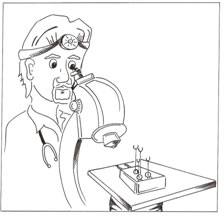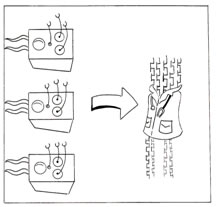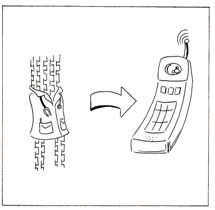Nanorobots and Subcellular Sensing
Order-of-magnitude feasibility calculations indicate that nanorobots (artificial machines with overall size of the order of a few micrometres or less in all spatial directions and constituted by nanoscopic components with individual dimensions in the interval 1-10² nm) are physically possible [1].
 Starting from the reasonable assumption that the current evolution of integrated circuits (ICs) will continue in the next 10 years, the IC will attain a density on the scale of 0.1 Tbit cm-2 (thus reaching the limits expectedly consistent with the Moore law) [2]. In this case chips with size of the same order as the cellular (say 10x10x1 μm3) one could host a number of devices (say 105) large enough to allow cellular sensing. Endowing these chips with functions (like motion, sensing, etc.) at the reach of nanotechnology would allow the preparation of nanorobots able to produce a shift of paradigm in medicine.
Starting from the reasonable assumption that the current evolution of integrated circuits (ICs) will continue in the next 10 years, the IC will attain a density on the scale of 0.1 Tbit cm-2 (thus reaching the limits expectedly consistent with the Moore law) [2]. In this case chips with size of the same order as the cellular (say 10x10x1 μm3) one could host a number of devices (say 105) large enough to allow cellular sensing. Endowing these chips with functions (like motion, sensing, etc.) at the reach of nanotechnology would allow the preparation of nanorobots able to produce a shift of paradigm in medicine.
Assuming temporarily the validity of the above scenario, such a development will eventually allow the production of the personal physician (PP), whose availability "will finally give physicians the most potent tools imaginable to conquer human disease, ill-health, and aging" [3].
Of course any major technological progress requires an adequate economic driving force to fuel the development. The potential market of the PP (of the order of 1010 systems, each of higher value than that of personal computer, PC) seems sufficient for that. The PP is constituted by two parts: a central unit, stably implanted in the organism, and a fleet of squads of shuttles, each squad being specialized to the different tissues and organs.
Each shuttle is a self-propelled nanorobot, able:
- - to take energy from the environment,
- - to recognize and dock the target cell,
- - to sense its membrane and neighborhood,
- - to recognize its health state,
- - to store the information,
- - to transfer it to the central unit, and
- - eventually (once allowed) to destroy the malignant cell.
At the present stage of knowledge, the hypothesized nanorobot is certainly far from being producible, but it is not an (irrational) dream because most of the critical steps required for its preparation have already been established.
 Exploring the whole cell surface with a step of 10³ nm would imply the collection of 10³ data (10² regions times 10 metabolites) for the chemical map of the cell surface. Assuming that each measurement requires 0.1 s (including positioning), mapping the entire cell would require approximately 10² s. The repetition of 10 mappings would thus require 103s and and their memorisation should occupy 10 kbit, about 10% of the entire circuitry. The choice of the set of metabolites is characterstic of the target tissue.
Exploring the whole cell surface with a step of 10³ nm would imply the collection of 10³ data (10² regions times 10 metabolites) for the chemical map of the cell surface. Assuming that each measurement requires 0.1 s (including positioning), mapping the entire cell would require approximately 10² s. The repetition of 10 mappings would thus require 103s and and their memorisation should occupy 10 kbit, about 10% of the entire circuitry. The choice of the set of metabolites is characterstic of the target tissue.
If the time evolution of a normal cell is known, exploring it for a duration lasting approximately 10³ s (about 1% of the characteristic cellular lifetime in mammalian tissues) is most likely sufficient to recognize if the cell is undergoing a physiological or pathological path. Assigning the comparison to the portion of logic not involved in memory, the device will be able to establish (with a certain accuracy) the health state of the cell. If the analysis of a cell requires indeed 103s, in one year the nanorobot will be able to test approximately 3x104 cells; in a tissue of 1 kg it will be able to explore approximately 3 parts per million of the whole tissue. The population of the family of nanorobots must be so chosen as to have an adequate statistical coverage of the tissue.
Once ill cells have been recognized, several strategies are possible: to insist over a more prolonged time to confirm the diagnosis, or to explore nearby cells to determine their health states. Genetic algorithms of research will drive the device toward zones of minimum health.
Once a nanorobot has confirmed the diagnosis of a pathology, it will drift toward, and eventually dock, the central unit (with complexity on the 10-10² Gbit scale) where the data on ill cells will be reversed. The central unit will collect information from all the specialized devices, and will eventually inform the physician (by calling its cellular phone) providing detailed information on the organism state.


The realization of such a complex system requires the solution of a lot of problems, covering biomimesis, power supply, propulsion, and data transmission. Biomimetic coatings designed not activate immune response of the organism are at the reach of the current technology, as shown by the several demonstrators of lipid monolayers or bilayers (mimicking biological membranes) supported on solid or polymer surfaces on even large areas [4]. Of course, the supported films are only weakly bound and are thus poorly stable; a larger stability, however, can likely be achieved by bonding covalently (e.g., via silanization) to the sensor surface molecules with carboxylic terminations, mimicking the outer surface of cells.
Supplying power to such a complex system is not trivial and most likely requires different solutions at different levels. The power required for the central unit is macroscopic and may be supplied either by external sources (batteries, electromagnetic coupling) or by implanted generators (stochastic microelectromechanical generators). More difficult is to supply power to the shuttles that, in view of their size (102 μm3), do not tolerate such features.
For fuelling and propelling nanorobots hybrid solutions must necessarily be found. An arrangement where the motion is imparted by the derivatization of the nanorobot with biomotors can be hypothesized: for instance, Montemagno and Bachand have reported the construction of nanomechanical devices powered by biomolecular motors [5], Kim and Breuer have described the successful use of live bacteria as mechanical actuators in microfabricated fluid systems [6], and Behkam and Sitti have exploited bacterial flagella for propulsion and motion control of microscale objects [7]. An enormous advantage of this solution is the fact that the motion does not require an alien input of energy for that the chemical energy available in the organism (in the form of adenosine triphosphate, ATP) can be exploited. The same form of energy can also be exploited for powering the electrical circuitry, because biomotors are reversible and can operate as engines too.
At present wireless transmission of data from the nano-robot to the central is seemingly insurmountable: radio-frequency transmission requires indeed an antenna whose size is most likely on the millimetre length scale. This practical impossibility requires that the shuttle periodically returns to the central unit to feed back it with the information on cellular health state.
In this light, other (likely more efficient) organizations are possible. For instance, one can imagine that in each squad the information is transported and reversed to a nearby stably implanted local unit where it is elaborated and transmitted via radio frequency to the central unit for the final elaboration in the light of the inputs coming from the other local units. After that, the relevant information is eventually transmitted to the external world.
Allowing the nano-robot to recognize the health state of the cell with relatively few parameters (say 10) on relatively few regions (say 102) over a relatively short time (say 102s) requires in any case a sufficiently simple built-in model of "standard cell".
Acknowledgement
Materials at the web page were presented by Professor Gianfranco Cerofolini, Department of Materials Science, University of Milano Bicocca, Italy. Artistic drawings by Valentina Busnelli. Photo art by Natalie and Dwight Hanson
References
[1] A. A. G. Requicha, "Nanorobots, NEMS, and nanoassembly" , Proc. IEEE 91, 1922-1933 (2003).[2] G. F. Cerofolini, "Nanoscale Devices" (Springer, Berlin, 2009).
[3] R. A. Freitas, Jr., "Current status of nanomedicine and medical nanorobotics", J. Comput. Theor. Nanosci. 2, 1-25 (2005).
[4] M. Tanaka, E.Suckmann, "Polymer-supported membranes as models of the cell surface" , Nature, 437, 656-663 (2005).
[5] C. Montemagno, G. D. Bachand, "Constructing nanomechanical devices powered by biomolecular motors", Nanotechnology 10, 225-231 (1999).
[6] M. J. Kim, K. S. Breuer, "Microfluidic pump powered by self-organizing bacteria", Small 4, 111-118 (2007).
[7] B. Behkam, M. Sitti, "Bacterial flagella-based propulsion and on/off motion control of microscale objects", Appl. Phys. Lett. 90, 023902 (2007).
